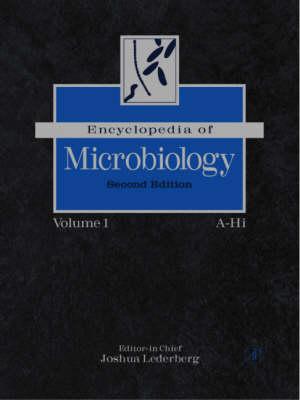Overview
The First Edition of the Encyclopedia of Microbiology was hailed by leading scientists and researchers around the world as excellent, outstanding, and impressive. This Second Edition will serve as an up-to-date version of this reference which has been useful to academic, industrial, and personal libraries for years. The Encyclopedia of Microbiology, Second Edition both challenges and stimulates the reader, and illustrates the importance of microbiology, a field that cannot be over emphasized in this booming biotechnology age.
Full Product Details
Author: Martin Alexander (The Rockefeller University, New York, U.S.A.) ,
Barry R. Bloom (Cornell University, Ithaca, New York, U.S.A.) ,
David A. Hopwood (Harvard School of Public Health, Boston, Massachusetts, U.S.A.) ,
Roger Hull (John Innes Centre and AFRC Institute of Plant Science Research, Norwich, UK)
Publisher: Elsevier Science Publishing Co Inc
Imprint: Academic Press Inc
Edition: 2nd edition
Dimensions:
Width: 21.60cm
, Height: 22.80cm
, Length: 27.90cm
Weight: 11.140kg
ISBN: 9780122268007
ISBN 10: 0122268008
Pages: 3848
Publication Date: 10 February 2000
Audience:
Professional and scholarly
,
Professional & Vocational
Format: Hardback
Publisher's Status: Unknown
Availability: Out of stock

Reviews
""The scope, detail, and organization of this four-volume set is truly remarkable...The complexity and array of subject matter covered in this book is awesome! Once the secret is out, this text should find itself on the office shelves of all professional microbiologists and in the library of every academic microbiology department throughout the world."" --CHOICE ""Four well-designed volumes include 298 articles. ...users will undoubtedly make heavy use of the detailed subject index. ...the second edition appears to meet the basic criteria of an excellent encyclopedia in design, organization, usability, and accuracy of data."" -Laurel Grotzinger in CHOICE (September 2000) Praise for the First Edition ""This survey of microbiology, consisting of 204 articles that vary in length from 6 to 30 pages, is well organized and well written... The material complements both undergraduate and graduate study... There is no comparable work. Highly recommended for libraries that support study, teaching, or research in microbiology."" --CHOICE ""Their [the articles']accuracy, as far as I can judge, is generally impeccable, and the level of clarity is commendably high."" --NATURE ""Occasionally a monumental works appears in press for readers to absorb the wealth of information and knowledge. Encyclopedia of Microbiology fits this billing!... I believe it is an excellent investment for a department of microbiology, food science, or foods and nutrition or a consultant laboratory. Certainly the set should grace the shelves of all university and public libraries."" --JOURNAL OF RAPID METHODS AND AUTOMATION IN MICROBIOLOGY ""There really is nothing else comparable in either coverage or currency on the market, and the encyclopedia is a valuable tool for both faculty and graduate students."" --LIBRARIES UNLIMITED ""The latest edition. updates the previous one and continues the tradition of quality set by the previous editions. The online edition via ScienceDirect provides electronic content for the six-volume print version of the third edition. Written by experts, the articles are up-to-date, clearly written, and well organized. The site arranges articles in broad categories and makes browsing by authors, article titles, and subjects easy; searching the full text of the encyclopedia works well. Given the breadth and depth of this resource, it will be very useful for students, scholars, and practitioners. Highly recommended.""--CHOICE
The scope, detail, and organization of this four-volume set is truly remarkable...The complexity and array of subject matter covered in this book is awesome! Once the secret is out, this text should find itself on the office shelves of all professional microbiologists and in the library of every academic microbiology department throughout the world. --CHOICE Four well-designed volumes include 298 articles. ...users will undoubtedly make heavy use of the detailed subject index. ...the second edition appears to meet the basic criteria of an excellent encyclopedia in design, organization, usability, and accuracy of data. -Laurel Grotzinger in CHOICE (September 2000) Praise for the First Edition This survey of microbiology, consisting of 204 articles that vary in length from 6 to 30 pages, is well organized and well written... The material complements both undergraduate and graduate study... There is no comparable work. Highly recommended for libraries that support study, teaching, or research in microbiology. --CHOICE Their [the articles']accuracy, as far as I can judge, is generally impeccable, and the level of clarity is commendably high. --NATURE Occasionally a monumental works appears in press for readers to absorb the wealth of information and knowledge. Encyclopedia of Microbiology fits this billing!... I believe it is an excellent investment for a department of microbiology, food science, or foods and nutrition or a consultant laboratory. Certainly the set should grace the shelves of all university and public libraries. --JOURNAL OF RAPID METHODS AND AUTOMATION IN MICROBIOLOGY There really is nothing else comparable in either coverage or currency on the market, and the encyclopedia is a valuable tool for both faculty and graduate students. --LIBRARIES UNLIMITED
Author Information
Dr. Joshua Lederberg is among the most eminent living biologists. He can be described as one of the founders of the field of bacterial genetics, which has become a crucial research area in modern biology. Leading genetics textbooks (e.g., Suzuki et al., Watson, et al.) will invariably begin the chapter on bacteria by describing the work of Lederberg and his colleagues, beacuse prior to their research, it had not even been established that bacteria had any means of exchanging genetic information, much less mechanisms by which this took place.In 1958, Joshua Lederberg received the Nobel Prize in Physiology or Medicine ""for his discoveries concerning genetic recombination and the organization of the genetic material of bacteria."" Drs. tatum and Beadle were co-recipients of the Prize.




